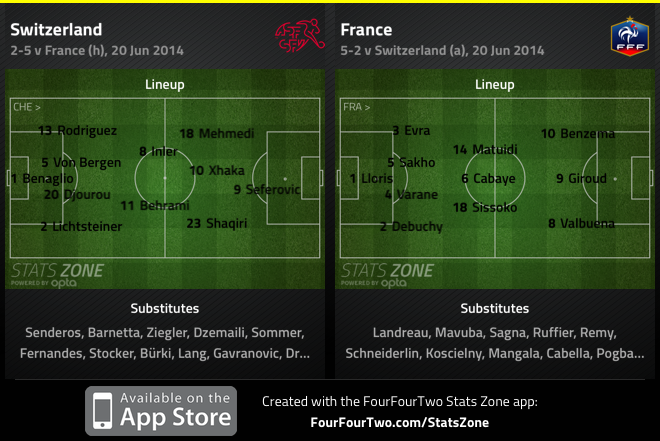Make no mistake, a draw away in Paris in what on paper is our toughest match of the group stages is a fine result. However from the team selection to the tactics this was a troubling performance.
Wenger used the only formation Wenger ever uses anymore, 4-2-3-1. He opted for Coquelin and Cazorla at the base of midfield. PSG lined up in a 4-3-3 with Adrien Rabiot, Marco Verratti and Grzegorz Krychowiak in their central midfield. We defended in banks of four with Ozil staying higher up the pitch with Alexis. This meant defensively Cazorla and Coquelin were outnumbered 2 v. 3 in the middle of midfield against the PSG midfield three. They were easily able to find the spare man and pass between our midfield and defensive lines.
Cazorla’s contributions in a deep-lying midfield role are often underappreciated. His ability to maintain possession when being pressed, spin off defenders and spot a forward pass is invaluable. He has a level of composure you simply don’t get from a Coquelin or Elneny. However when he plays as part of a double pivot against a side playing a 4-3-3 (as opposed to a 4-2-3-1 with a #10 high up the pitch) it becomes much easier for the opposition to overrun us in midfield. Cazorla is obviously a physically small player. It’s a lot to ask of him to be one of only two center midfielders patrolling the center of the pitch when the opposition has the ball.
Tactically the difficulty is that the presence of Ozil, our best player and therefore one we have to have on the pitch, almost necessitates the 4-2-3-1 formation because Ozil needs to play in a #10 role behind the striker. He’s not a box-to-box midfielder that is going to get back behind the ball when we concede possession and contribute defensively. He therefore can’t play as one of the box-to-box shuttlers in a 4-3-3. So when Ozil and Cazorla both play we have two players in the middle of the pitch that aren’t physically imposing in the defensive side of the game. Therefore Cazorla’s partner in the double pivot role (Coquelin last night) has to be very disciplined and do the lions share of ball winning and defensive covering.
One way to get around this issue would be to have Cazorla play at the base of midfield with two more energetic shuttling midfielders either side of him. Andrea Pirlo was able to operate as a deep lying creator at Juventus because he had Paul Pogba and Arturo Vidal as center midfield partners to do the ball winning for him and provide direct running in attack to link play forward. We could mimic that strategy with perhaps Cazorla playing at the base of midfield with Elneny and Xhaka either side of him to provide the legs in the middle of the pitch. Ramsey would also be a great option in the shuttling role when he returns.
The down side to this 4-3-3 with Cazorla as deep lying creator of course is that it forces us to play Ozil wide (unless Wenger played with a diamond 4-4-2 with Cazorla at the base and Ozil at the tip; he wouldn’t). He’d have to do more defending, which he’s not great at, and it would push him further from those areas between the opposition midfield and defense where he is at his most dangerous. However, he has played the wide role effectively, most notably during Germany’s 2014 World Cup winning run but also at times in the beginning of last season for Arsenal (or was it the season before?).
I’m not sure what the best answer is. I think Cazorla is a stronger player deeper in midfield than in the #10 spot he played when he arrived at Arsenal and I think we play at a far higher tempo and with more attacking penetration when he’s on the pitch. With an Elneny/Coquelin combination you don’t have that really creative deep lying passer that can pick out a forward pass. As a result the tempo slows down considerably and we end up passing the ball sideways from sideline to sideline.
However, against strong opposition you may not have enough defensive cover with Cazorla as part of a double pivot with Ozil as the #10. This was hardly the only tactical issue from Tuesday evening. Our defense was so disjointed at times it makes you wonder if there was a tactical plan going into this game at all. It seems we’re never on the same page as to whether we’re pressing as a unit or sitting in deep behind the ball. Half our players are doing one thing, the other half are doing something different. The image below shows one particularly terrifying example from Tuesday evening.
I’m convinced now more than ever that the game has passed Wenger by. I wonder if he doesn’t become self conscious about his own tactical nous as his counterparts in the technical area are barking out tactical instructions and making changes over the course of the 90 minutes that influence the complexion of the contest. Wenger will make more or less like for like substitutions but never any big changes. We were bailed out last night by Cavani’s poor finishing but there was no indication that this Arsenal side can do any better in the knockout stages than recent iterations. I fear that as long as Wenger stays in charge it’ll be season after season of “new year, same old Arsenal.”

















